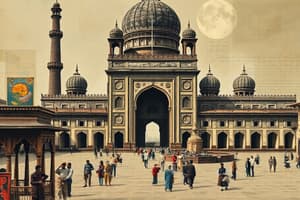Podcast
Questions and Answers
What was the response of Raja Dahir when Hajjaj bin Yousef sent his emissary to convert the pirates to Islam?
What was the response of Raja Dahir when Hajjaj bin Yousef sent his emissary to convert the pirates to Islam?
- He agreed to convert
- He refused to convert (correct)
- He offered to negotiate
- He asked for more time
Who was the ruler of the Umayyad dynasty when an overarching incidence of ship looting occurred near Debal?
Who was the ruler of the Umayyad dynasty when an overarching incidence of ship looting occurred near Debal?
- Muhammad bin Qasim
- Walid bin Abdul Malak (correct)
- Suleman bin Abdul Malak
- Hajjaj bin Yousef
What was the impact of Sufism during the Sultanate period in the Sub-continent?
What was the impact of Sufism during the Sultanate period in the Sub-continent?
- It caused religious unrest
- It boosted religious reformists and saints (correct)
- It caused a decline in architecture
- It led to a decrease in literature
What replaced the Umayyad dynasty in 750 A.D?
What replaced the Umayyad dynasty in 750 A.D?
What was the result of Muhammad bin Qasim's expeditions?
What was the result of Muhammad bin Qasim's expeditions?
Flashcards are hidden until you start studying
Study Notes
- Islam spread rapidly in the world after emerging in the world in the 8th century, but it took its root in the Indo-Pak Sub-continent.
- During the rule of sixth Umayyad caliph, Walid bin Abdul Malak (705-715 A.D), when an overarching incidence of ship looting occurred near Debal, a sea port, some Hindu pirates were converted to Islam.
- Hajjaj bin Yousef sent his emissary to the Rajput king, Raja Dahir, to convert the pirates to Islam, and Raja Dahir was blunt in his response.
- Muhammad bin Qasim was then sent to teach the Raja a lesson and establish Islamic society/rule in Sindh.
- Qasim continued to expand the Muslim society beyond Sindh and marched up to Multan where he defeated Raja Gor Singh.
- During this time several changes occurred that made his expeditions slow down and finally put a halt.
- Hajjaj bin Yousef had been died in 714 A.D, and within months administrative changes wrought in Damascus.
- Suleman bin Abdul Malak was replaced by his brother Suleman bin Abdul Malak (715-717 A.D), and the new ruler was extravagantly luxury loving and quite incompetent.
- Qasim was then sent to teach the Raja a lesson and establish Islamic society/rule in Sindh, but he was killed in the prison at the age of just 22.
- With the passage of time rule of Umayyads finally evaporated in 750 A.D. and was succeeded by the Abbasids.
- The Abbasid rulers time after time sent their governors in the Sub-continent. According to Ibn Haukal, who traveled extensively through the Arab domains around the middle of the 8th Century, particularly mentioned the affluence of the people of Sindh. Moreover, during the rule of Abbasid caliph Al-Mansur (754-775 A.D), scholars from the Sindh were welcomed at the court of Baghdad.
- In the north Islam was making inroads from Afghanistan into the north-western region of Pakistan. Islamic missionaries were actively spreading their faith among the tribes.
- The Muslim society flourished during the Sultanate period in the Sub-continent.
- Sufism made its way during this era and gave a boost to religious reformists and saints.
- The Muslim rule in India is particularly known for its architecture, literature and impact on religious reformists and saints.
- This period of Muslim rule changed the lifestyle and thinking of the people of the Sub-continent.
- The Muslim society gave a welcome fillip to the cultural, economic and social environment in the Sub-continent.
Studying That Suits You
Use AI to generate personalized quizzes and flashcards to suit your learning preferences.




